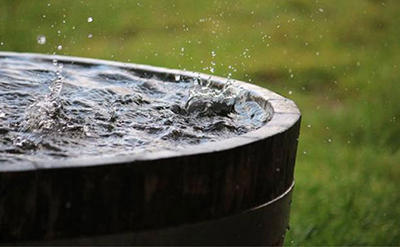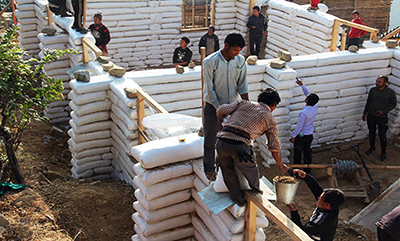Rainwater Harvesting
A Sustainable Water Management to Counter Water Scarcity.
The sewerage from our houses can be divided into two types, Greywater and Blackwater. Greywater consists of wastewater from Kitchen, washing basins, laundry, sinks, and showers. While the blackwater consists of waste products from toilets mainly consisting of urine and feces. If collected separately, it is easy to filter and reuse the greywater for irrigation purposes. Separated greywater has a low concentration of pollutants and its treatment would be easier than mixed wastewater. The concept of an onsite wastewater differentiable treatment system can be one of the suitable systems for off-the-grid areas where there is no central sewerage system. In large parts of the world, centralized sewerage is still not available. If reuse purpose is focused on irrigation only advanced treatment technology for nitrogen, phosphorus removal would not be necessary. The most important point is to be low cost and simple because most of those who need greywater reuse are low-income people.

Among alternative water sources, rainwater harvesting systems have a lower cost and less risky option for human health. The structure of the rainwater harvesting system varies depending on the climatic conditions of the location, the reliability of rainfall, consumer demand, and the quality of the required rainwater.
Types of Rainwater Harvesting Systems:
There are two types of rainwater harvesting systems depending upon the use of rainwater.
- Active Rainwater Harvesting:
Active rainwater harvesting is where rainwater is stored for use at a later date. Rainwater can be stored in above-ground or underground cisterns, ponds, or other storage receptacles. Rainwater can be used in many ways once it has been stored, i.e., for irrigation, fountains, ponds, animals, and domestic uses for humans. - Passive Rainwater Harvesting:
Passive water harvesting is where rainwater is stored on the site where it falls and is infiltrated into the ground for landscapes and groundwater recharge. Passive water harvesting means not letting runoff water leave a specific site. Once it is set up, costs and maintenance are minimal. It does not require storage tanks. Soak away pits are constructed to let this water enter the groundwater system.
Components of Rainwater Harvesting System:
A good rainwater harvesting system makes use of maximum rain. The volume of water you harvest will depend on the surface area of your roof and the size of the storage tank. When the storage tank is full, we can still make use of rainwater by percolating it to groundwater with the help of soak away pits.
The rainwater harvesting systems are divided into four main subsystems:
- Collection
- Treatment
- Storage
- Distribution
The structure of each subsystem varies according to the availability of the components and local applications. The first step of the rainwater harvesting system is the collection of rainwater.
1- Collection:
A septic tank is an enclosed watertight container that collects and provides primary treatment of wastewater by separating solids from the wastewater. It removes the solids by holding wastewater in the tank and allowing the settleable solids to settle to the bottom of the tank while the floatable solids (oil and greases) rise to the top. To provide time for the solids to settle, the tank should hold the wastewater for at least 24 hours. A typical septic tank has two compartments. The septic tank can be of any materials discussed above. The first compartment should be a little bit wider than the second compartment as the majority of the solid waste deposition takes place in the first compartment. These two compartments are connected through a baffle (a Tee pipe) and separated with a wall. A precast septic tank is mostly used instead of making the one at the site.

Gutter:
Without gutters, you can’t catch the water that falls on your roof. Including the right piping and gutters means the water will run off the roof and into your tank without collecting unneeded debris. The most common materials for gutters and downspouts are half-round PVC, vinyl, pipe, seamless aluminum, and galvanized steel. The gutters should be sized so that they adequately move rainwater runoff from a 100-year storm event. As a general rule, gutters should be at least 5 inches.
Downspouts:
Without gutters, you can’t catch the water that falls on your roof. Including the right piping and gutters means the water will run off the roof and into your tank without collecting unneeded debris. The most common materials for gutters and downspouts are half-round PVC, vinyl, pipe, seamless aluminum, and galvanized steel. The gutters should be sized so that they adequately move rainwater runoff from a 100-year storm event. As a general rule, gutters should be at least 5 inches.


Leaf Filter:
Having the right filtration system in place is critical. A sophisticated filtering system is needed to ensure harmful contaminants are removed. Leaf screens are installed along the gutter, in the downspouts, and at the entrance of the water storage tank.
First Flush Diverter:
When the first lot of rain hits your roof and runs into your gutters, the water often contains a lot of pollutants from the air and debris on the roof. The first flush diverter is a popular system that includes a valve that ensures the runoff from the first spell of rain is flushed out and does not enter the system.


2. Treatment:
When rainwater reaches the ground, it gets filled with debris and other pollutants. So, there is a dire need to filter this water. The rainwater should be treated before it reaches the groundwater table. Filters are used for the treatment of water to effectively remove turbidity, color, and microorganisms. After the first flushing of rainfall, water should pass through filters. Gravel, sand, and ‘netlon’ mesh filter are designed and placed on top of the storage tank. This filter is very important in keeping the rainwater in the storage tank clean. It removes silt, dust, leaves, and other organic matter from entering the storage tank. The filter media should be cleaned daily after every rainfall event. Clogged filters prevent rainwater from easily entering the storage tank and the filter may overflow. The sand or gravel media should be taken out and washed before it is replaced in the filter. There are different types of filters in practice, but the basic function is to purify water. Different types of filters are described in the following section.
- Sand Gravel Filter:
These are commonly used filters, constructed by brick masonry and filleted by pebbles, gravel, and sand. Each layer should be separated by wire mesh. - Charcoal Filter:
Charcoal filters can be made in-situ or in a drum. Pebbles, gravel, sand, and charcoal as shown in the figure should fill the drum or chamber. Each layer should be separated by wire mesh. The thin layer of charcoal is used to absorb odor if any. - PVC Pipe Filter:
This filter can be made by PVC pipe of 1 to 1.20 m in length; the Diameter of the pipe depends on the area of the roof. Six inches dia. pipe is enough for a 1500 sq. Ft. roof and 8 inches dia. pipe should be used for roofs more than 1500 sq. Ft. Pipe is divided into three compartments by wire mesh. Each component should be filled with gravel and sand alternatively as shown in the figure. A layer of charcoal could also be inserted between two layers. Both ends of the filter should have a reduction of the required size to connect the inlet and outlet. This filter could be placed horizontally or vertically in the system.
Treatment of Overflowing Water:
The overflowing water or the water which should reach the ground level should also be treated. If your storage tank is full, then the overflow water is treated with natural sand, gravel, and rubble bed filter. There should be a separate area in which overflowing water should get treated and percolate to groundwater. For this dug a trench of some suitable size. The size of this trench depends on the amount of rainwater. Place a layer of sand, gravel, and rubbles in layers in the pit. Overflowing water gets treated by a natural filter and may percolate to ground water.
3. Storage:
In the active rainwater harvesting method, rainwater collected from the roof of the building is diverted to a storage tank. The storage tank has to be designed according to the water requirements, rainfall, and catchment availability. Each drainpipe should have a mesh filter at the mouth and first flush device followed by a filtration system before connecting to the storage tank. Each tank should have an excess water overflow system. Excess water could be diverted to the recharge system. Water from storage tanks can be used for secondary purposes such as washing and gardening etc. This is the most cost-effective way of rainwater harvesting. The main advantage of collecting and using rainwater during the rainy season is not only to save water from conventional sources but also to save energy incurred on transportation and distribution of water at the doorstep. This also conserves groundwater, if it is being extracted to meet the demand when rains.

4. Distribution:
Water from the storage tank can be distributed to toilets, washbasins, etc. depending upon the quality of water. Water from storage can be used for secondary purposes such as washing and gardening. The distribution component of rainwater harvesting includes all of the piping, pumps, and other devices that move water from the storage and treatment to the point of use. If you are using a rainwater harvesting system for drip irrigation by gravity flow, the distribution system may simply be a length of drip tubing. However, if you plan to use the water indoors under pressure, there will be a few more key components. (*Piping water into a home involves complex water pressure and should be done by a licensed plumber. If you plan to connect the rainwater to a plumbing system where municipal water already exists, you must check with local laws/ordinances to determine what type of backflow prevention devices are necessary.
Methods of Rainwater Harvesting [PDF] – Article
How to recharge underground water – English – Youtube Video
Rainwater Harvesting – Download PDF
Rainwater Harvesting (WhitePaper Explanation in Urdu/Hindi) – Youtube Video




